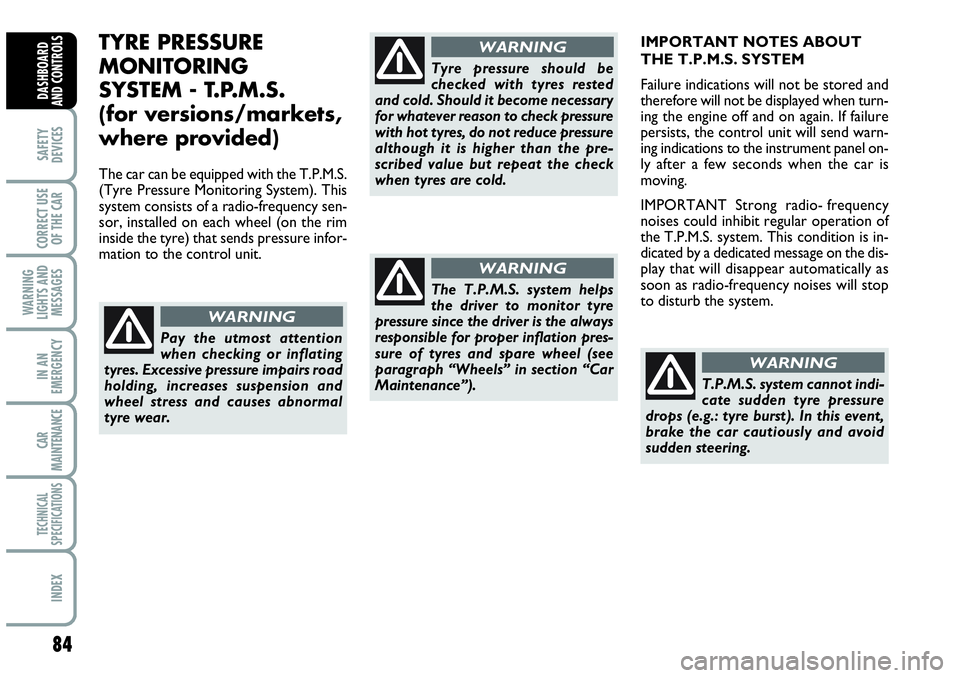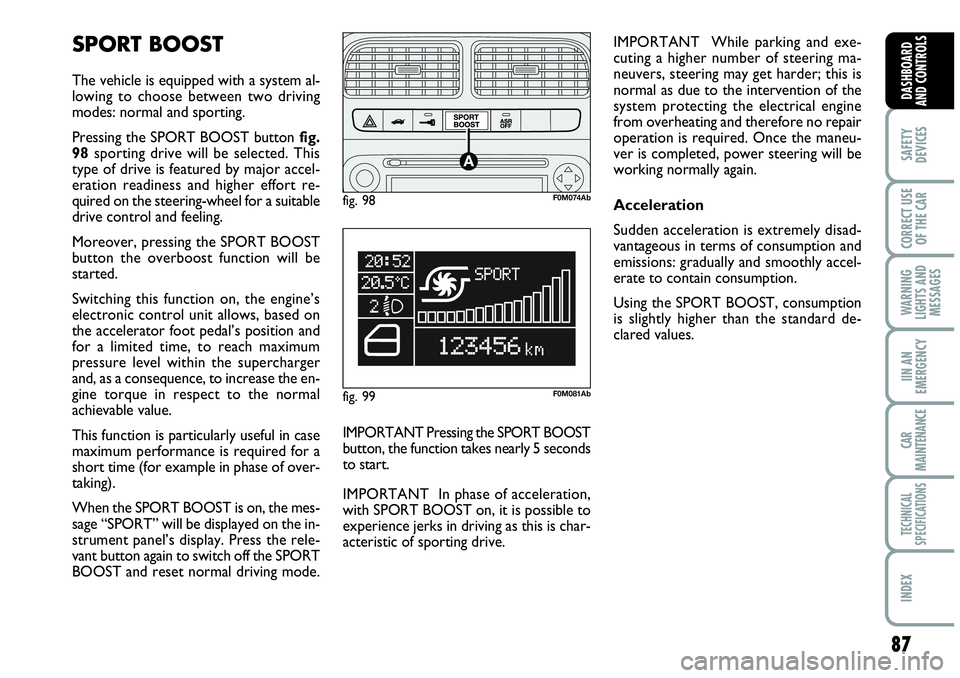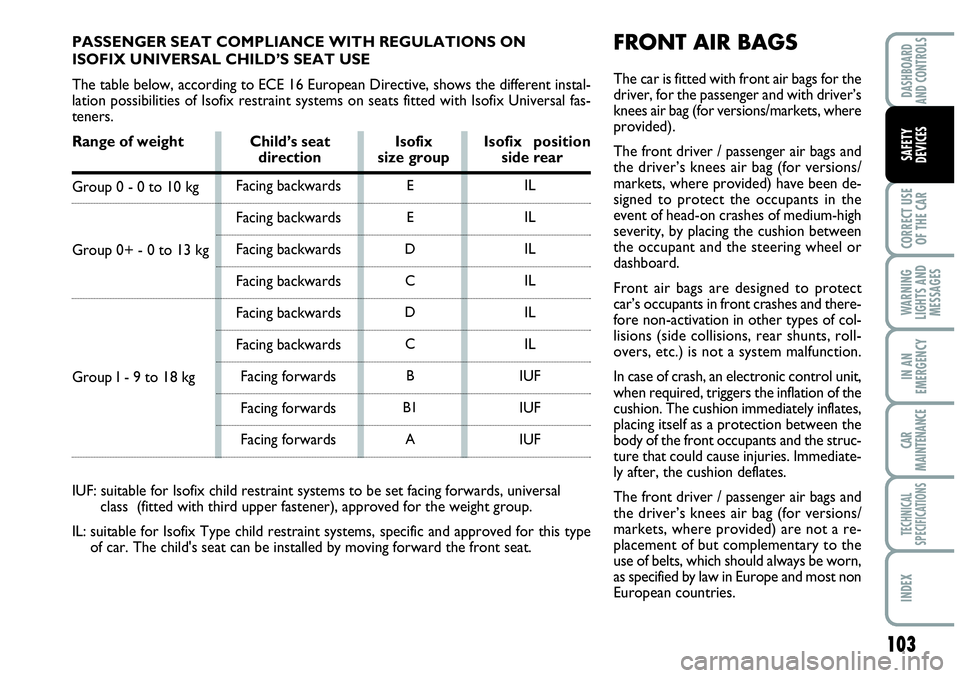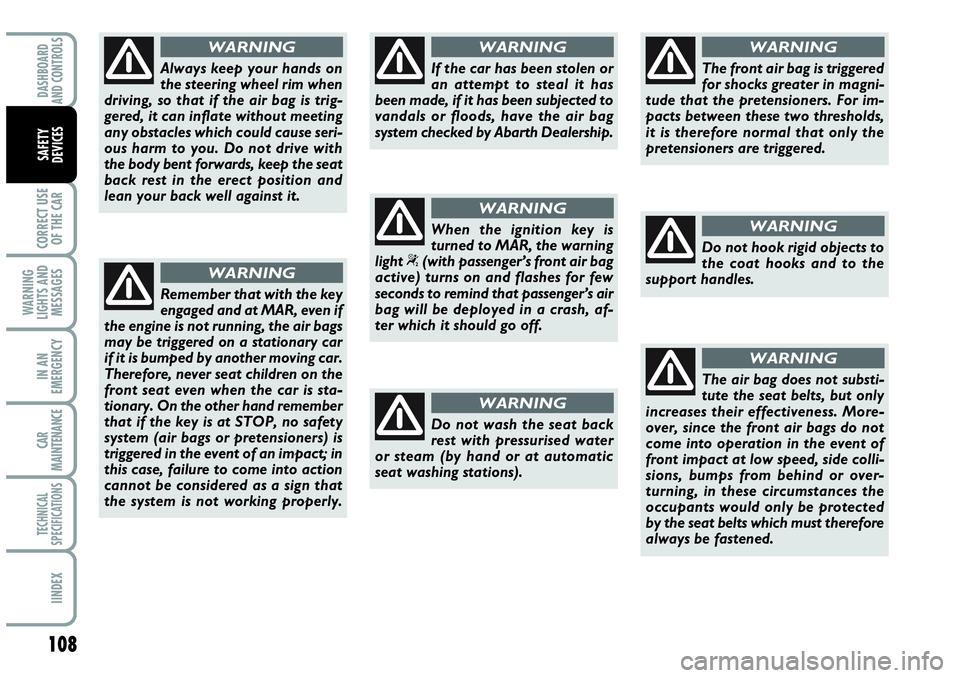steering Abarth Grande Punto 2010 Owner handbook (in English)
[x] Cancel search | Manufacturer: ABARTH, Model Year: 2010, Model line: Grande Punto, Model: Abarth Grande Punto 2010Pages: 207, PDF Size: 3.01 MB
Page 86 of 207

84
SAFETY
DEVICES
CORRECT USE
OF THE CAR
WARNING
LIGHTS AND
MESSAGES
IN AN
EMERGENCY
CAR
MAINTENANCE
TECHNICAL
SPECIFICATIONS
INDEX
DASHBOARD
AND CONTROLS
TYRE PRESSURE
MONITORING
SYSTEM - T.P.M.S.
(for versions/markets,
where provided)
The car can be equipped with the T.P.M.S.
(Tyre Pressure Monitoring System). This
system consists of a radio-frequency sen-
sor, installed on each wheel (on the rim
inside the tyre) that sends pressure infor-
mation to the control unit.IMPORTANT NOTES ABOUT
THE T.P.M.S. SYSTEM
Failure indications will not be stored and
therefore will not be displayed when turn-
ing the engine off and on again. If failure
persists, the control unit will send warn-
ing indications to the instrument panel on-
ly after a few seconds when the car is
moving.
IMPORTANT Strong radio- frequency
noises could inhibit regular operation of
the T.P.M.S. system. This condition is in-
dicated by a dedicated message on the dis-
play that will disappear automatically as
soon as radio-frequency noises will stop
to disturb the system.
Pay the utmost attention
when checking or inflating
tyres. Excessive pressure impairs road
holding, increases suspension and
wheel stress and causes abnormal
tyre wear.
WARNING
Tyre pressure should be
checked with tyres rested
and cold. Should it become necessary
for whatever reason to check pressure
with hot tyres, do not reduce pressure
although it is higher than the pre-
scribed value but repeat the check
when tyres are cold.
WARNING
The T.P.M.S. system helps
the driver to monitor tyre
pressure since the driver is the always
responsible for proper inflation pres-
sure of tyres and spare wheel (see
paragraph “Wheels” in section “Car
Maintenance”).
WARNING
T.P.M.S. system cannot indi-
cate sudden tyre pressure
drops (e.g.: tyre burst). In this event,
brake the car cautiously and avoid
sudden steering.
WARNING
Page 89 of 207

87
SAFETY
DEVICES
CORRECT USE
OF THE CAR
WARNING
LIGHTS AND
MESSAGES
IIN AN
EMERGENCY
CAR
MAINTENANCE
TECHNICAL
SPECIFICATIONS
INDEX
DASHBOARD
AND CONTROLS
SPORT BOOST
The vehicle is equipped with a system al-
lowing to choose between two driving
modes: normal and sporting.
Pressing the SPORT BOOST button fig.
98sporting drive will be selected. This
type of drive is featured by major accel-
eration readiness and higher effort re-
quired on the steering-wheel for a suitable
drive control and feeling.
Moreover, pressing the SPORT BOOST
button the overboost function will be
started.
Switching this function on, the engine’s
electronic control unit allows, based on
the accelerator foot pedal’s position and
for a limited time, to reach maximum
pressure level within the supercharger
and, as a consequence, to increase the en-
gine torque in respect to the normal
achievable value.
This function is particularly useful in case
maximum performance is required for a
short time (for example in phase of over-
taking).
When the SPORT BOOST is on, the mes-
sage “SPORT” will be displayed on the in-
strument panel’s display. Press the rele-
vant button again to switch off the SPORT
BOOST and reset normal driving mode. IMPORTANT While parking and exe-
cuting a higher number of steering ma-
neuvers, steering may get harder; this is
normal as due to the intervention of the
system protecting the electrical engine
from overheating and therefore no repair
operation is required. Once the maneu-
ver is completed, power steering will be
working normally again.
Acceleration
Sudden acceleration is extremely disad-
vantageous in terms of consumption and
emissions: gradually and smoothly accel-
erate to contain consumption.
Using the SPORT BOOST, consumption
is slightly higher than the standard de-
clared values.
IMPORTANT Pressing the SPORT BOOST
button, the function takes nearly 5 seconds
to start.
IMPORTANT In phase of acceleration,
with SPORT BOOST on, it is possible to
experience jerks in driving as this is char-
acteristic of sporting drive.
fig. 98F0M074Ab
fig. 99F0M081Ab
Page 105 of 207

103
CORRECT USE
OF THE CAR
WARNING
LIGHTS AND
MESSAGES
IN AN
EMERGENCY
CAR
MAINTENANCE
TECHNICAL
SPECIFICATIONS
INDEX
DASHBOARD
AND CONTROLS
SAFETY
DEVICES
FRONT AIR BAGS
The car is fitted with front air bags for the
driver, for the passenger and with driver’s
knees air bag (for versions/markets, where
provided).
The front driver / passenger air bags and
the driver’s knees air bag (for versions/
markets, where provided) have been de-
signed to protect the occupants in the
event of head-on crashes of medium-high
severity, by placing the cushion between
the occupant and the steering wheel or
dashboard.
Front air bags are designed to protect
car’s occupants in front crashes and there-
fore non-activation in other types of col-
lisions (side collisions, rear shunts, roll-
overs, etc.) is not a system malfunction.
In case of crash, an electronic control unit,
when required, triggers the inflation of the
cushion. The cushion immediately inflates,
placing itself as a protection between the
body of the front occupants and the struc-
ture that could cause injuries. Immediate-
ly after, the cushion deflates.
The front driver / passenger air bags and
the driver’s knees air bag (for versions/
markets, where provided) are not a re-
placement of but complementary to the
use of belts, which should always be worn,
as specified by law in Europe and most non
European countries. Facing backwards
Facing backwards
Facing backwards
Facing backwards
Facing backwards
Facing backwards
Facing forwards
Facing forwards
Facing forwards
IL
IL
IL
IL
IL
IL
IUF
IUF
IUFE
E
D
C
D
C
B
B1
A
PASSENGER SEAT COMPLIANCE WITH REGULATIONS ON
ISOFIX UNIVERSAL CHILD’S SEAT USE
The table below, according to ECE 16 European Directive, shows the different instal-
lation possibilities of Isofix restraint systems on seats fitted with Isofix Universal fas-
teners.
Range of weight Child’s seat Isofix Isofix position
direction size group side rear
Group 0 - 0 to 10 kg
Group 0+ - 0 to 13 kg
Group I - 9 to 18 kg
IUF: suitable for Isofix child restraint systems to be set facing forwards, universal
class (fitted with third upper fastener), approved for the weight group.
IL: suitable for Isofix Type child restraint systems, specific and approved for this type
of car. The child's seat can be installed by moving forward the front seat.
Page 106 of 207

104
CORRECT USE
OF THE CAR
WARNING
LIGHTS AND
MESSAGES
IN AN
EMERGENCY
CAR
MAINTENANCE
TECHNICAL
SPECIFICATIONS
IINDEX
DASHBOARD
AND CONTROLS
SAFETY
DEVICES
PASSENGER’S FRONT AIR BAG
fig. 15
It consists of an instant-inflating cushion
contained into a special recess in the dash-
board, this cushion has a volume bigger
than that of the driver. In minor crashes (for which the restrain-
ing action of the seat belts is sufficient), the
air bags are not deployed. Also in this case
it is of vital importance to wear the seat
belts since in case of side crash they guar-
antee proper positioning of the occupant
and prevent the occupants to be pitched
out of the car in case of violent crashes.
DRIVER’S FRONT AIR BAG fig. 14
It consists of an instant-inflating cushion
contained in a special recess in the cen-
tre of the steering wheel.
Do not apply stickers or oth-
er objects to the steering
wheel or to the air bag cover on the
passenger’s side or on the side roof
lining. Never put objects (e.g. mobile
phones) on the dashboard on pas-
senger side since they could interfere
with proper air bag inflation and al-
so cause serious injury.
WARNINGThe volume of front air bags at max. in-
flation fills most of the space between the
steering wheel and the driver and between
the dashboard and the passenger.
In case of crash, a person not wearing the
seat belt moves forward and may come in-
to contact with the cushion while it is still
inflating. Under this circumstance the pro-
tection offered by the air bag is reduced.
Front air bag may not be activated in the
following situations:
❒in collisions against highly deformable
objects not affecting the car front sur-
face (e.g. bumper collision against guard
rail, etc.);
❒ in case of wedging under other vehicles
or protective barriers (for example un-
der a truck or guard rail), the air bag
is not triggered as it offers no additional
protection compared with the seat
belts, consequently it would be point-
less. Therefore, failure to come into ac-
tion in the above circumstance does
not mean that the system is not work-
ing properly.
fig. 14F0M031Ab
fig. 15F0M032Ab
Page 110 of 207

108
CORRECT USE
OF THE CAR
WARNING
LIGHTS AND
MESSAGES
IN AN
EMERGENCY
CAR
MAINTENANCE
TECHNICAL
SPECIFICATIONS
IINDEX
DASHBOARD
AND CONTROLS
SAFETY
DEVICES
Always keep your hands on
the steering wheel rim when
driving, so that if the air bag is trig-
gered, it can inflate without meeting
any obstacles which could cause seri-
ous harm to you. Do not drive with
the body bent forwards, keep the seat
back rest in the erect position and
lean your back well against it.
WARNING
Remember that with the key
engaged and at MAR, even if
the engine is not running, the air bags
may be triggered on a stationary car
if it is bumped by another moving car.
Therefore, never seat children on the
front seat even when the car is sta-
tionary. On the other hand remember
that if the key is at STOP, no safety
system (air bags or pretensioners) is
triggered in the event of an impact; in
this case, failure to come into action
cannot be considered as a sign that
the system is not working properly.
WARNING
Do not wash the seat back
rest with pressurised water
or steam (by hand or at automatic
seat washing stations).
WARNING
The front air bag is triggered
for shocks greater in magni-
tude that the pretensioners. For im-
pacts between these two thresholds,
it is therefore normal that only the
pretensioners are triggered.
WARNING
Do not hook rigid objects to
the coat hooks and to the
support handles.
WARNING
The air bag does not substi-
tute the seat belts, but only
increases their effectiveness. More-
over, since the front air bags do not
come into operation in the event of
front impact at low speed, side colli-
sions, bumps from behind or over-
turning, in these circumstances the
occupants would only be protected
by the seat belts which must therefore
always be fastened.
WARNING
When the ignition key is
turned to MAR, the warning
light “(with passenger’s front air bag
active) turns on and flashes for few
seconds to remind that passenger’s air
bag will be deployed in a crash, af-
ter which it should go off.
WARNING
If the car has been stolen or
an attempt to steal it has
been made, if it has been subjected to
vandals or floods, have the air bag
system checked by Abarth Dealership.
WARNING
Page 112 of 207

110
WARNING
LIGHTS AND
MESSAGES
IN AN
EMERGENCY
CAR
MAINTENANCE
TECHNICAL
SPECIFICATIONS
INDEX
DASHBOARD
AND CONTROLS
SAFETY
DEVICES
CORRECT USE
OF THE CAR
ENGINE STARTING
The car is fitted with an electronic engine
lock device: if the engine fails to start, see
the paragraph “The Fiat CODE system” in
section “Dashboard and controls”.
The engine may be noisier than usual dur-
ing the first seconds of operation, espe-
cially after it has not been used for a while.
This characteristic feature does not com-
promise functionality or reliability of the
hydraulic tappets: the timing system de-
vised to limit servicing.
We recommend that during
the initial period you do not
drive to full car performance
(e.g.: excessive acceleration,
long journeys at top speed, sharp brak-
ing, etc.).
When the engine is switched
off never leave the key into
the ignition switch to prevent
pointless current absorption
from draining the battery.
Running the engine in con-
fined areas is extremely dan-
gerous. The engine consumes oxygen
and produces carbon monoxide
which is a highly toxic and lethal gas.
WARNING
Remember that the servo-
brake and power steering
are not operational until the engine
has been started, therefore much ef-
fort than usual is required on the
brake pedal and steering wheel.
WARNING
Proceed as follows:
❒ensure that the handbrake is up;
❒put the gear lever into neutral;
❒ press the clutch pedal down to the
floor without touching the accelerator;
❒turn the ignition key to AVVand let
it go the moment the engine starts.
If the engine does not start at the first at-
tempt, return the ignition key to STOP
before repeating starting.
If, when the ignition key is at MAR, warn-
ing light
Yremains lit together with
warning light Uturn the key to STOP
STOP and then back to MAR; if the warn-
ing light remains on, try with the other
keys provided with the car.
IMPORTANT If the instrument panel
warning light Ystays on glowing steadi-
ly, contact immediately Abarth Dealership.
IMPORTANT Never leave the ignition key
to MARwhen the engine is off.
Page 113 of 207

111
WARNING
LIGHTS AND
MESSAGES
IN AN
EMERGENCY
CAR
MAINTENANCE
TECHNICAL
SPECIFICATIONS
INDEX
DASHBOARD
AND CONTROLS
SAFETY
DEVICES
CORRECT USE
OF THE CAR
STOPPING THE ENGINE
Turn the ignition to STOPwhile the en-
gine is idling.
IMPORTANT After a taxing drive, you
should allow the engine to “catch its
breath” before turning it off by letting it
idle to allow the temperature in the en-
gine compartment to fall.
A quick burst on the acceler-
ator before turning off the en-
gine serves absolutely no
practical purpose, it wastes
fuel and is damaging especially to tur-
bocharged engines.HOW TO WARM UP THE
ENGINE AFTER IT HAS JUST
STARTED
Proceed as follows:
❒ Drive off slowly, letting the engine turn
at medium revs. Do not accelerate
abruptly;
❒Do not drive at full performance for the
initial kilometres. Wait until the coolant
temperature gauge starts moving.
Remember that the servo-
brake and power steering are
not operational until the en-
gine has been started, there-
fore much effort than usual is required
on the brake pedal and steering wheel.
Never bump start the engine
by pushing, towing or coast-
ing downhill as this could
cause fuel to flow into the
catalytic exhaust system and damage
it beyond repair.
Page 136 of 207

134
WARNING
LIGHTS AND
MESSAGES
CAR
MAINTENANCE
TECHNICAL
SPECIFICATIONS
IINDEX
DASHBOARD
AND CONTROLS
SAFETY
DEVICES
CORRECT USE
OF THE CAR
IN AN
EMERGENCY
ENGINE
STARTING
EMERGENCY START-UP
If the
Ysign keeps being displayed, im-
mediately call the Abarth Dealership.
JUMP STARTING fig. 1
If the battery is flat, it is possible to start
the engine using an auxiliary battery with
the same capacity or a little higher than
the flat one. Proceed as follows:
❒connect positive terminals (+near the
terminal) of the two batteries with a
jump lead;
❒with a second lead, connect the nega-
tive terminal (–) of the auxiliary battery
to an earthing point
Eon the engine or
the gearbox of the car to be started;
❒ start the engine;
❒when the engine has been started, re-
move the leads reversing the order
above.
If after a few attempts the engine does not
start, do not insist but contact the near-
est Abarth Dealership.
IMPORTANT Do not directly connect the
negative terminals of the two batteries:
sparks could ignite the flammable gas from
the battery. If the other battery is fitted in
another car, prevent accidental contacts
between the metal parts of the two cars.BUMP STARTING
Never bump start the engine (by pushing,
towing, or coasting downhill) as this could
cause fuel to flow into the catalytic ex-
haust system and damage it beyond repair.
IMPORTANT Remember that the brake
booster and the power steering system
are not operating until the engine is start-
ed, a greater effort will therefore be re-
quired to press the brake pedal or turn
the steering wheel.
The starting procedure must
be carried out by qualified
personnel because incorrect opera-
tions may cause electrical discharge of
considerable intensity. The liquid con-
tained in the battery is poisonous and
corrosive. Avoid contact with the skin
and eyes. Keep naked flames and light-
ed cigarettes away from the battery
and do not cause sparks.
WARNING
fig. 1F0M104Ab
Page 157 of 207

155
WARNING
LIGHTS AND
MESSAGES
CAR
MAINTENANCE
TECHNICAL
SPECIFICATIONS
INDEX
DASHBOARD
AND CONTROLS
SAFETY
DEVICES
CORRECT USE
OF THE CAR
IN AN
EMERGENCY
USERSFUSE AMPERE
ESP electric steering system control unit (+ignition power supply), NFR braking
system control unit (+ignition power supply), yaw sensor on tunnel
Left fog light, right fog light
Spare
Current socket (preparation)
Passenger compartment, cigar lighter current socket
Reversing light, relay coils on engine fuse junction unit
Defroster on driver’s door mirror, defroster on passenger side door mirror24
30
84
85
86
87
885
15
–
–
15
5
7.5
Page 161 of 207

159
WARNING
LIGHTS AND
MESSAGES
CAR
MAINTENANCE
TECHNICAL
SPECIFICATIONS
INDEX
DASHBOARD
AND CONTROLS
SAFETY
DEVICES
CORRECT USE
OF THE CAR
IN AN
EMERGENCY
TOWING THE CAR
The tow ring provided with the car is
housed in the tool box under the boot
mat.
TOW RING HOOKING fig. 39
Proceed as follows:
❒release the cap A;
❒take the tow hook Bfrom the sup-
port;
❒tighten the ring on the rear or front
threaded pin.
When towing, remember that
without the help of the ser-
vobrake and power steering, a greater
effort is required on the pedal and
steering wheel. Do not use flexible ca-
bles for towing and avoid jerks. During
towing operations make sure that fas-
tening the joint to the car does not
damage the components in contact
with it. When towing the car, you must
comply with the specific traffic regu-
lations regarding the tow ring and how
to tow on the road.
WARNING
fig. 39F0M043Ab